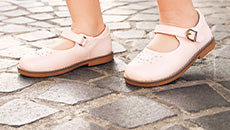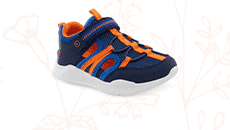Kids' Foot Facts
Kids' feet grow and develop throughout childhood. With so many important changes happening, it's vital to safeguard their healthy development with shoes that are perfectly suited to their foot size, shape and stage of growth.
Without the right shoes, little feet could feel discomfort and develop foot problems over time, and your child could even experience delayed progress with important milestones like walking.
Get the answers to all of your little foot-related questions with our kids' shoes FAQs.
Click on a question below to see the answer.
- How do kids' feet develop?
- Pre-crawling (infant)
- Crawling (baby)
- Toddler
- Kindergartener (and beyond!)
- How fast do kids' feet grow?
- When should babies start wearing shoes?
- Baby vs. Toddler Shoes: What matters?
- What are the best shoes for babies?
- What are the best shoes for toddlers?
- What are the best school shoes for kids?
- What features do the best kids' shoes have?
- Can kids wear hand-me-down or secondhand shoes?
- Are there shoes for kids with flat feet?
- Are there kids' shoes with arch support?
- Should I buy my kids wide shoes?
- What do kids' shoe sizes mean?
- What shoe size do babies wear?
- What's the average shoe size for a 3-year-old, 4-year-old, etc.?
- What size shoe does my child wear?
- How do you measure kids' feet for shoes?
- How do you convert US sizes to European kids' shoe sizes?
- How do I check if my kids' shoes fit right?
- How often should I measure my kids' feet?
- How long do kids' shoes last?
- Where can I buy kids' shoes?
- Kids' shoe terms and glossary
How do kids' feet develop?
It takes around 24 months for a newborn's foot bones to fully develop. This makes selecting footwear that's designed specifically for a baby's growing feet all the more crucial in their first two years.
Feet continue to grow and strengthen into the teen years. So, your kid's tenth pair of shoes is just as important as their very first.
To catch you up to speed, here are the main stages of children's foot development.
Pre-crawling (infant)
An infant's feet are flat and mainly consist of cartilage. The bones haven't fully developed yet. Most pediatricians recommend letting infants go shoeless so their feet can fully sense their environment.
Crawling (baby)
As a baby begins to crawl, shoes become increasingly important for protection. When your baby reaches the standing and cruising stages, they benefit from soft, low-to the ground, lightweight shoes that will protect their feet whenever they're outside the house.
Our Soft Motion collection is specifically designed for little feet taking their very first steps.
Toddler
Once your child is walking independently, they should be upgraded to sturdier shoes that still support sensory response. Choose light, soft shoes that replicate the foot's natural shape to help them gain confidence.
Between the ages of 2 to 4, your child's feet will develop rapidly. Their bones continue to form, their muscles tone, and their joints fuse together. Flat feet are still normal at this point because their muscles are still strengthening.
Our SRtech collection includes special sensory pods to support the natural development of toddlers' feet.
Kindergartener (and beyond!)
By the time your child is ready to start school, their feet will start looking like mini-versions of adult feet. After the age of 5, their feet will usually have developed an arch, and they will be running, leaping and dancing all over the place.
Until their mid-teens, your kid's feet will continue to grow about a size per year.
During this action-packed stage, our SRtech and washable Made2Play collections are most suitable.
How fast do kids' feet grow?
Believe it or not, kids' feet can grow a half size or more every 2 to 4 months! The rate of growth generally depends their age, but many kids' feet will grow faster or slower at different stages.
| Under 15 months old | feet grow about 1/2 size every 2 months. |
| 15 months to 2 years old | feet grow about 1/2 size every 2-3 months. |
| 2 to 3 years old | feet grow about 1/2 size every 3-4 months. |
| 3 to 5 years old | feet grow about 1/2 size every 4 months |
See our Size Guide for more info on when and how to measure your kid's feet for shoes.
When should babies start wearing shoes?
Until your baby starts standing and walking, staying barefoot will help them develop the proprioception they need to balance take their first steps. When you need to protect their feet outdoors or while tottering around, the shoes you choose should be designed specifically for baby feet so they don't interfere with normal development, like our Soft Motion shoes.
Baby vs. Toddler shoes: what matters?
Despite being close in age, babies and toddlers need different things from their shoes.
Baby shoes
Choose light, flexible baby shoes with soft, slip-free rubber soles. Look for rounded heels and edges that mimic the actual shape of a baby's foot.
Toddler shoes
For toddlers, look for sensory enhancing shoes that are made to support balance, coordination and fine motor development. Footwear should be light, durable, and reinforced for stability, with rounded edges and rubber soles.
What are the best shoes for babies?
If you've ever watched a baby take their first deliberate steps, it won't surprise you that their feet actually hit the ground with more impact than adult feet. That's why it's so important that their shoes are built to provide maximum stability and sensory response while still offering protection.
At Stride Rite, our Soft Motion shoes are soft, lightweight and flexible to perfectly support a baby's first steps. We use anatomically correct lasts to shape our baby shoes so feet stay low to the ground and perfectly supported. Our Soft Motion collection uses rubber outsoles with multidirectional grooves to prevent slips and trips while staying flexible.
What are the best shoes for toddlers?
Toddlers need shoes to enhance their natural development. Whether your kid is a rookie walker or running rings around you, we recommend our SRtech shoes.
Made with special Sensory Response Technologytm, these shoes have outsoles with sensory pods to help improve children's balance and coordination. Each shoe is comfy and lightweight to never slow them down, while being durable and supportive enough for the playground and beyond.
What are the best school shoes for kids?
Kids care about style, but you care about safety. Stride Rite offers both. Find playground-ready sneakers in our Made2Play collection, which are 100% machine-washable and come with shockproof soles, memory foam, and antimicrobial linings. Slip-resistant rubber soles make our M2P shoes a favorite for gym class, recess and all their favorite play date activities.
Got a dress code to deal with? For kids with uniform requirements, we have school shoes for boys and girls' school shoes in classic yet stylish designs, all featuring our signature durability, comfort and Seal of Approval from the American Podiatric Medical Association (APMA).
What features do the best kids' shoes have?
When it comes to picking the best kids' shoes, it's really all about fit. You want shoes designed with real kids in mind. Look for rubber soles that are lightweight and flexible, but still offer optimal shock absorption and slip resistance. The shoes should have rounded edges that match the natural shape of kids' feet.
Look through our SRtech and Made2Play collections for some great choices.
Can kids wear hand-me-down or secondhand shoes?
No. We strongly discourage parents from putting their children in used shoes. After a shoe has been worn by one kid for a while, it forms to the shape of their specific foot. Kids' feet need proper support to promote healthy development and avoid foot problems down the road – putting them in shoes that are already worn down in places puts them at risk for the wrong kind of support.
Are there shoes for kids with flat feet?
Kids often have flat feet until their fifth birthday. It takes that long for the foot muscles to develop and lift the arch naturally. That's why it's so important to buy shoes that enhance a child's ability to sense and respond to the ground beneath them.
Shoes that claim to be designed for flat-footed children are often misleading or an outright myth. The best footwear for children is sized and fitted to support natural muscle and arch development. That said, you know your child best. If you sense that something is wrong or worry that your kids' feet aren't developing properly, you should consult a child podiatrist for expert advice.
Are there kids' shoes with arch support?
Kids' arches are strengthened naturally as they learn to walk. Wearing shoes that are too thick or inflexible can inhibit proper growth and actually weaken your child's arches, increasing their odds of developing flat feet later in life – remember, many little ones have flat feet until the age of five.
Should I buy my kids wide shoes?
If you suspect that your child has wide feet, use our Size Guide to get an accurate measurement. Stride Rite provides three different width measurements (M, W, and XW) so every size foot is properly supported.
What do kids' shoe sizes mean?
Baby shoe sizes are usually labeled by age in months. Little kids typically wear shoes ranging from size 3.5 to size 10, and big-kid sizes start at size 10.5. Once your child outgrows their size 13.5 kids' shoes, they graduate into adult sizes. So, their next pair will likely be a size 1.
For more information on kids' shoe sizes, use our Size Guide.
What shoe size do babies wear?
Generally, baby shoes are sized by age in months. But before you buy new shoes for those itty-bitty feet, use our Size Guide to measure their feet accurately and determine the proper size – some babies grow faster than others!
Our Soft Motion shoes for babies are sized by length and width to ensure a perfect fit.
What's the average shoe size for a 3-year-old, 4-year-old, etc.?
All children grow at different rates. So, we always recommend measuring your kid's feet prior to ordering a new pair of Stride Rite shoes. If you're buying shoes as a gift, your best bet is asking the child's parents for their shoe size.
Stride Rite does have a returns and exchange policy. You can send shoes back within 45 days with the original receipt for a full refund, unless the purchase was marked final sale.
What size shoe does my child wear?
Your child's shoe size depends on the length and circumference of their foot. Consult our Size Guide for at-home measuring tools and how-to videos.
How do you measure kids' feet for shoes?
It's best to bring your child to a Stride Rite location for a professional in-store fitting. You can also measure your child's feet at home with our guided or tracing methods. Visit our Size Guide to learn how.
How do you convert US sizes to European kids' shoe sizes?
Just like adult shoes, kids' shoes in Europe and the UK are sized differently than shoes sold in the US. Generally, baby shoes in the UK are labeled a full size smaller than their US counterparts. The exception is US baby size 1, which are a size 0.5 in the UK.
European baby shoes range from whole sizes 16-30. European shoes for toddlers start at adult size 23 and continue to increase by half sizes until they are fully grown.
If you're buying Stride Rite shoes from the UK, you'll generally want to order one size up. If you're in Europe, use a European shoe size conversion chart to check the corresponding US size, or contact a Stride Rite team member for support.
How do I check if my kids' shoes fit right?
Parents need to examine their children's new shoes for adequate length and width, toe shape, support, and ease of movement.
How often should I measure my kids' feet?
Children's feet can grow half a size or more every 2 to 4 months. Measure your kid's feet every two months to ensure their shoes are still fitting well.
How long do kids' shoes last?
Stride Rite footwear is designed for maximum durability and made from high-quality materials. Before we release any new shoes to the public, they undergo vigorous testing to ensure they'll stand up to whatever abuse your little one puts them through.
Of course, most kids outgrow their shoes before they're too worn to wear! If your child starts complaining of foot pain or discomfort, it could be a sign that their shoes no longer fit. And if the soles on your kid's shoes develop holes, it's definitely time to grab a new pair.
Where can I buy kids' shoes?
Find all the best kids' shoes online at Stride Rite! To try on shoes in person, visit a Stride Rite store near you, and get sizing help from our trained staff.
Kids' shoe terms and glossary
Last
A last is a holding device that's shaped like a human foot. Shoemakers use lasts to create or repair footwear. Lasts can be made from various materials including wood, plastic and cast iron. Stride Rite uses anatomically correct lasts to ensure our kids' shoes match the feet that go inside them.
Lighted
Lighted is the name of Stride Rite's light-up shoes line. Lighted shoes are available for boys and girls in an array of fun, flashy styles, including washable designs.
Lining
Lining refers to the inside of a shoe.
M2P
M2P is the abbreviation for Stride Rite's Made2Play washable shoes line. These easy-to-clean shoes are built to last, featuring athletic styling and scuff-resistant toe protection.
Outsole
The outsole refers to the bottom of a shoe.
Proprioception
Proprioception describes the way in which joints and muscles send messages to the brain to help coordinate movement. Usually unconscious, this motor skill develops naturally as a child learns to walk and can be inhibited by ill-fitting or inflexible shoes.
Sock
The sock refers to the footbed of a shoe.
Soft MotionTM
Soft Motion is Stride Rite's baby shoes line. Lightweight, flexible and well padded, they're designed to mimic the feeling of being barefoot as little ones take their first steps.
SRtechTM
Built for next steps, SRtech is the abbreviation for Stride Rite's shoes with Sensory Response Technology™. Designed for toddlers and school-aged kids, shoes with SRtech have sensory pods to support proprioception so kids can improve their balance and walking skills.
Upper
The upper refers to the top part of a shoe.

 Why Stride Rite?
Why Stride Rite?




